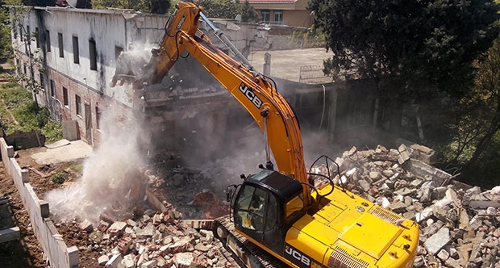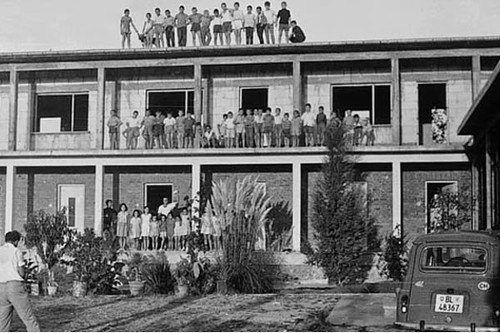Protesting for Kamp Armen in Istanbul. Photo: Barış Paksoy
“The genocide continues”: Kamp Armen under threat
- June 3, 2015
City & Commons
In Turkey the cultural genocide of minority groups continues. Now, a Gezi-like resistance movement tries to turn the tide and build a common future.
- Author
The spirit of resistance has taken root in Tuzla, a wealthy, beachside suburb on the Anatolian side of Istanbul. Getting off the bus after an hours’ drive from the Bosporus, a series of spraypainted signs direct one past gated communities and celebrity villas to a hidden plot of land where once the songs and laughter of hundreds of Armenian children brought life to a now derelict and partially demolished school building.
‘Welcome to Camp Armen’ reads a sign at the entrance in both Turkish and Armenian. A narrow driveway covered by flags from Nor Zartonk – a political association founded by Armenians which fights for minority rights in Turkey – and flanked by walls covered in political slogans leads to site where for almost one month people have successfully resisted the destruction of the former Tuzla Armenian Orphanage.
On May 6 – a mere two weeks after the 100th commemoration of the Armenian genocide – bulldozers arrived at the site of the abandoned school building and immediately set to work in demolishing the structure. One entire wing was leveled before local activists who had been warned by sympathetic construction workers that were building a villa next door arrived on the scene and threw themselves in front of the machines to try and save what was left of the school.
A threat to the state
The Tuzla Armenian Orphanage, or Camp Armen as it was commonly known, was built in 1963 on a plot of land newly bought by the Gedikpasa Armenian Church. It was started as a summer school where Armenian language and culture was kept alive. The children carried rocks and sand from the nearby seashore, and helped with the construction of the building itself. Trees were planted and a vegetable garden was created.
“We were making cheese, yoghurt and butter. There was always something to do,” remembers Garabet Orunüz, who spent his youth in the camp. “This was our home, and we were doing everything with our love. We were enjoying it.”
For twenty years the camp provided a home for Armenian children. Some of them were orphans who spent several years living at the camp, and some of them were from Anatolia, from small villages were there was little or no chance to be educated in the traditions of their people, who came just to spend the summer months.
In 1983, the camp was closed because of rumors that Muslim children were converted to Christianity there, and a slander campaign in which the school was pictured as a training ground for terrorists. The property rights of the land were returned to the formed owner based on a 1974 high court ruling which stated that minority foundations cannot own property.
This racist policy came into effect after the military coup of 1971. Minority foundations came to be seen as a threat to the unity of the state, and it was made illegal for them to acquire any real estate, either through purchase or inheritance.
The line was drawn at 1936, when a new law forced all minority religious foundations to register their property. All the properties acquired by these foundations after 1936 were declared illegal under the 1974 ruling, and either confiscated by the state or returned to their former owners – as was the case with the plot where the Armen Camp had been built.
Lessons learned
One of the most famous students of the school was Hrant Dink, the Turkish-Armenian editor and journalist who was assassinated in Istanbul in 2007. Dink was very dedicated to the camp where he spent a large share of his youth and where he also met his wife, Rakel Dink. Before his death, he had plans to make a documentary and write a book about the camp, but he never managed to realize this. In response to the seizure of the land he wrote the following:
They seized the fruit of the sweat of the 1500 children who grew up here. They stole our child labor. They could still have my blessing if only they had continued our place as an orphanage for poor children, a camp for the needy or challenged youngsters of whatever identity. But grabbed by a handful of villains as it is, I deny them the blessing of my labor.
Between 1983 and now, the building has remained vacant, except for a single warden who lived on the property to protect it from thieves and vandals. In that time it has changed owners half a dozen times – increasing the value of the land with every sale – but none showed any particular interest in it. Until one month ago, when the current owner of the land, Fatih Ulusoy, decided to demolish the school and use the plot to construct sixteen villas.
As soon as the news broke that the school was under threat, a call for solidarity was shared via social media. Activists, campaigners and sympathizers rushed to the scene where they managed to convince the operator of the bulldozer to lay down his work. They then occupied the building and set up tents in the former garden of the school. An average of twenty people are guarding the site around the clock, but on weekends these numbers rise as many people come and show their solidarity.
“We didn’t give the park, and we won’t give our school!”, is written on one of the banners, in a clear link to the Gezi Park resistance that kicked off in Istanbul two years earlier. The occupiers claim they have learned a lot from the Gezi resistance, in terms of organization, tactics and solidarity. Özgür Atlagan, one of the activists, explains: “We reacted so quickly because of the experience that we acquired during Gezi. Everything we do here, cooking, cleaning, organizing forums, they are the habits that we learned in the park.”
The resistance seemed to be successful when Ulusoy publicly announced that he would return the land title to the Gedipasa Armenian Church. This announcement was widely covered in the media as a victory for the Armenians and their sympathizers, and the ruling AKP didn’t waste any time in claiming that they had played a key role in the negotiations. However, more than one week after the deadline, the title deeds have still not been transferred, and activists on the scene are afraid their case is being used for propaganda in the upcoming elections.
Genocide continues
“The genocide continues!” reads one of the largest banners hanging from the school’s walls. Just two weeks before the occupation of Camp Armen started this very same banner was used by the activists of Nor Zartonk at the 100th commemoration of the Armenian genocide. When Alexis Kalk, a founding member of the organization, was asked by one of his comrades which banner to bring to the school site, he only thought for one second before replying: “the one about the genocide!’
“For us, the Armenians who live in Turkey, the genocide really continues. There are many different tools that can be used in a genocide: economic pressure, cultural degradation, forced assimilation. This country has never been punished for the crimes it committed, and so it doesn’t hesitate to repeat them again.”
Garabet Orunüz, the old student of the school couldn’t agree more. In his view the closure of the school back in 1983 was part of what he calls a ‘cultural genocide’. “What was the place for us? Our home. What were we learning from there? Our language, our religion, our culture. So, when they close this place they deprived us of all these things. This is a cultural genocide.”
The hopes and dreams of all those who have a part in the resistance have one thing in common, and that is that they would all like to see the school being restored in its original function. As a place were cultures and traditions are being kept alive, and not exclusively Armenian. The plan is to turn the school into part orphanage, part summer school for children from all different religious and ethnic backgrounds across Turkey to come together, learn to respect each other and make the hate and racism that has been guiding the actions of the rulers of this country for so long history.
The different backgrounds of the occupiers — there are Armenians as well as Turks, Kurds, Alevis and a number of foreigners — and the amount of solidarity they received from groups as diverse as the Anarchist federation, the Kazova workers and the Jewish community, gives rise to the thought that in resisting this latest chapter of the ongoing cultural genocide one of the most important aims has already been achieved. Once again, just like two years ago during the occupation of the Gezi Park, there is unity in resistance, solidarity across socially constructed boundaries, and a shared belief that despite a divided past there is hope for a common future.
The struggle at Camp Armen continues.
Stay up to date on the latest developments via their website or Facebook page.
Source URL — https://roarmag.org/essays/kamp-armen-turkey-istanbul/




